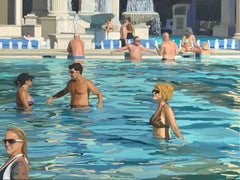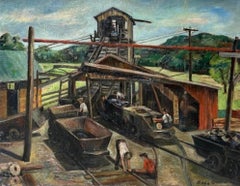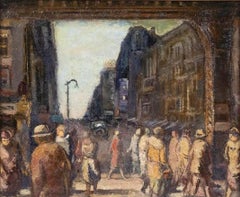Richard Baker Art
to
1
Overall Width
to
Overall Height
to
1
1
1
1
1
1
1
1
1
1
1
1
9,539
2,719
1,374
1,366
1
1
Artist: Richard Baker
VIVA LAS VEGAS – Sunlit Caesar's Palace Pool with Bathers, Oil on Canvas, 30x40
By Richard Baker
Located in Palm Desert, CA
As if envisioned for a Hollywood film, "Viva Las Vegas" is a striking work of Contemporary Realism by American artist Richard Baker. Painted in oil on canvas, this frozen moment capt...
Category
21st Century and Contemporary American Realist Richard Baker Art
Materials
Canvas, Oil
Related Items
Industrial Railroad WPA Mid 20th Century American Scene Rural Modern Realism
By Louis Bosa
Located in New York, NY
Industrial Railroad WPA Mid 20th Century American Scene Rural Modern Realism
Large oil on canvas genre painting depicting laborers working on a railroad, with rural landscape in the...
Category
1940s American Realist Richard Baker Art
Materials
Canvas, Oil
$11,500
H 29 in W 35 in D 3 in
Columbus Avenue NYC c. 1920s/30s American Scene Ashcan WPA Modern 20th Century
By Bernard Gussow
Located in New York, NY
Columbus Avenue NYC c. 1920s/30s American Scene Ashcan WPA Modern 20th Century
"Late Afternoon, Columbus Avenue, New York", impasto oil on canvas, signed lower left, signed verso (under relining, shown in photo), and titled verso on stretcher, in maple mitered cove frame, 23 1/4" x 27 1/4", SS: 19 1/4" x 23 1/4", Relined.
BIO
Russian-born Gussow trained at the Art Students League and the National Academy of Design. He also studied under Bonnat at the Ecole des Beaux-Arts in Paris. His first claim to fame was exhibiting two works at the Armory Show in 1913. Gussow exhibited at the Society of Independent Artists between 1917 and 1934 and at Salons of America in the 1930s.
The Whitney Museum of American Art, for example, has his Subway Stairs. The Barnes Foundation...
Category
1920s American Realist Richard Baker Art
Materials
Canvas, Oil
"Snowy City Scene" American Scene Social Realism WPA Era Mid-20th Century Modern
Located in New York, NY
"Snowy City Scene" American Scene Social Realism WPA Era Mid-20th Century Modern
Syd J. Browne (1907-1991)
"Snowy City Scene"
22 x 30 inches
Oil on canvas. c. 1930s
Signed lower lef...
Category
1930s American Realist Richard Baker Art
Materials
Canvas, Oil
Puddle Jumper. Woman With Umbrella Original Oil American Rainy Scene Painting.
Located in Marco Island, FL
An ordinary scene of a woman walking down a sidewalk in the rain is elevated to a little gem of a painting. American life is captured in this Clyde Singer painting, Puddle Jumper (...
Category
Late 20th Century American Realist Richard Baker Art
Materials
Canvas, Oil
$3,500
H 15.5 in W 13.5 in
Calder Sculpture in Lincoln Center- New York City American Scene Painting
Located in Marco Island, FL
Clyde Singer was a master at capturing the moments, small and significant in everyday American life. This painting, "Calder Sculpture in Lincoln Center", is a glimpse of an ordinar...
Category
1970s American Realist Richard Baker Art
Materials
Oil, Canvas
$14,000
H 34 in W 35 in D 2 in
A Surprise Dinner Guest. Outdoorsman and Bear in Snowy Forest Camp Painting.
Located in Marco Island, FL
A dynamic narrative painting titled A Surprise Dinner Guest (or An Unexpected Guest), showing the moment an outdoorsman sees the bear approaching his snowy campsite. Presented in a...
Category
Early 20th Century American Realist Richard Baker Art
Materials
Canvas, Oil
"High School Dance" WPA Mid-20th Century Modern American Scene Social Realism
Located in New York, NY
"High School Dance" WPA Mid-20th Century Modern American Scene Social Realism
Heusing (20th Century)
"High School Dance"
27 x 32 inches
Oil on canvas
Signed and dated '47 Lower Righ...
Category
1940s American Realist Richard Baker Art
Materials
Canvas, Oil
NYC EL American Scene Social Realism Mid 20th Century Modern WPA Era Figurative
By Cecil Crosley Bell
Located in New York, NY
NYC EL American Scene Social Realism Mid 20th Century Modern WPA Era Figurative
Cecil Bell (1906 – 1970)
Street Life Under the EL
22 x 30 inches
Oil on canvas, c. 1930s
Signed upper...
Category
1930s American Realist Richard Baker Art
Materials
Canvas, Oil
London Round House-Mid-Century Industrial American Scene Oil Painting
By Jack Steele
Located in Marco Island, FL
A mid-century American Realist scene of children playing on the railroad entitled, London Round House. The chaotic scene of children rambunctiously playing is suspected to be set in...
Category
1940s American Realist Richard Baker Art
Materials
Canvas, Oil
$14,000
H 52 in W 43 in D 3 in
Hotel Night Lobby. Large Mid-Century American Oil Painting.
Located in Marco Island, FL
A long and quiet night in the hotel lobby is depicted by Clyde Singer in this moody and still painting. Entitled Hotel Night Lobby (1947), Singer paints a moment of solitude during ...
Category
1940s American Realist Richard Baker Art
Materials
Oil, Canvas
"Pelham Bay" WPA American Scene Social Realism Modern NYC Subway Transportation
Located in New York, NY
"Pelham Bay" WPA American Scene Social Realism Modern NYC Subway Transportation
Daniel Ralph Celantano (1902-1980)
"Pelham Bay"
12 1/4 x 16 inches
Oil on canvas
Signed lower cente...
Category
1930s American Realist Richard Baker Art
Materials
Oil, Canvas
Morning Beneath the EL NYC American Scene WPA Modern 20th Century Social Realism
By Bernard Gussow
Located in New York, NY
"Morning Beneath the EL" NYC American Scene Ashcan WPA Modern 20th Century Social Realism
Bernard Gussow (1881-1957)
"Morning Beneath the EL"
24 1/4 x 30 inches
Oil on canvas
Signed...
Category
1930s American Realist Richard Baker Art
Materials
Canvas, Oil
Richard Baker art for sale on 1stDibs.
Find a wide variety of authentic Richard Baker art available for sale on 1stDibs. You can also browse by medium to find art by Richard Baker in paint, canvas, fabric and more. Much of the original work by this artist or collective was created during the 21st century and contemporary and is mostly associated with the abstract style. Not every interior allows for large Richard Baker art, so small editions measuring 22 inches across are available. Customers who are interested in this artist might also find the work of Ralph Anderson, Shao Yuan Zhang, and Michael Gallagher. Richard Baker art prices can differ depending upon medium, time period and other attributes. On 1stDibs, the price for these items starts at $1,200 and tops out at $10,000, while the average work can sell for $9,500.


